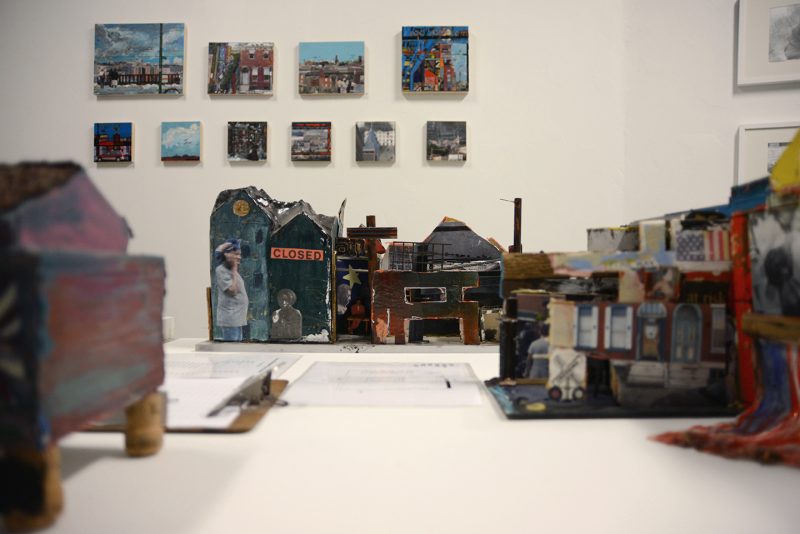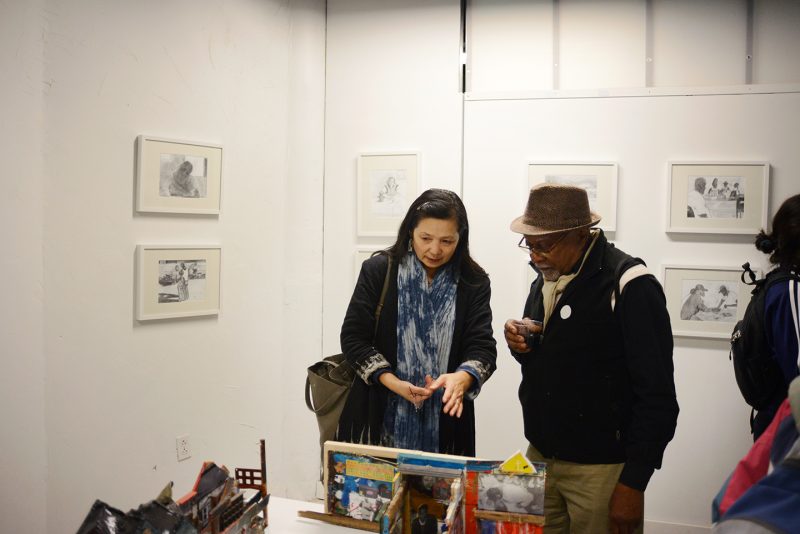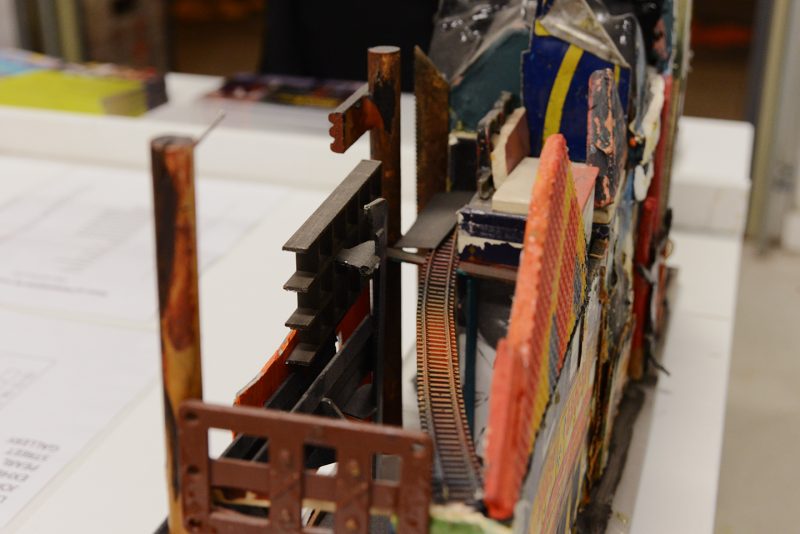
Leroy Johnson: Views of Philadelphia captures the Philadelphia native’s observations of the city as it evolved during his lifetime, focusing on the nitty-gritty, unheroic details that exist in the deprived neighborhoods that surround the prosperous city center.
Johnson’s series of small 2-D works–in paint, mixed media, and assemblage–depict real people in real or altered Philadelphia settings. The various pieces demonstrate the artist’s instinct for placement of found objects, paper clippings, and other materials that suggest or directly refer to a specific places in the city and moments in its history.
Most of the works focus on the results of gentrification that continues to take place in Philadelphia, where the the displacement of people and things have transformed them all into a kind of debris. While it’s not stated overtly, the emphasis on impoverished people and forgotten neighborhoods infuses the show with political meaning. Due to its political content and focus on urban decay, debris, and poverty, you won’t find pretty views of Philadelphia.

The artist’s expressive touch–a mix of precise content supplied by collaged photographs and thick expressionistic paint in the background and foreground–might seem primitive. To me it is an indication of an artist whose need to tell a story trumps status quo rules about materials that create neither “paintings” or “collages” but hybrids of both. The urban storytelling is further extended by Johnson’s assemblages, giving a tangible quality to his overall approach to making these works–an approach which Johnson refers to as “Urban Expressionism”–where the thick brushstrokes, graffiti-like colors, rapidly rendered subjects, words, and clippings of text are used as a communicative tool in the service of social and political issues.
The show also includes a series of new pencil sketches that were inspired by a ten-week open studio art workshop led by Johnson at the Sunday Breakfast Rescue Mission located on Pearl Street.

In the latest series of the untitled sketches, the artist looks closely at the residents of the Rescue Mission. Many of the individuals portrayed are of different racial backgrounds and may have once inhabited the very same streets or neighborhoods depicted in the artist’s other works. Yet these sketches seem cursory, distant and, to some extent, can seem ambiguous as they offer the viewer no deeper insight into who these individuals are or what their real story is, nor do they offer any hope or solution to the problems of homelessness and hunger.
According to Asian Arts Initiative’s Program Manager, Cecilia Yen, “capturing the little everyday moments and elevating them into art is something that Leroy is really excellent at doing in his work.” Evidence of this can be seen in the mixed media painting and collage piece entitled “Columbus,” in which Johnson has cut out and placed images of three African American men on a high vantage point that overlooks the squeezed-in cityscape. Johnson has chosen to depict one of the men in Islamic clothing, while a sign advertising “Halal Steaks” is partially obscured by a lamppost–details that allude to the African American population that has embraced Islam. The man placed in the middle turns to us, smiling, while the third man carrying his backpack (maybe a student?) completes the trio, who are meant to represent the inhabitants of the city before them. Around the three figures, Johnson has painted a rather bleak winter scene of partially melted snow, though he offers some hope against the distant evolving downtown cityscape by allowing the gray clouds to give way to an azure sky, and a flock of birds to take flight across the canvas.

Johnson’s assemblages continue to reflect the gritty urban landscape of Philadelphia. These assemblages do not function as a subversive take on poverty, race or gender. Instead, they directly address controversial topics such as gun violence in the United States.
In the sculpture entitled “No Violence,” a cut-out of a young man is shown seated behind a desk on top of which lays a handgun. He looks up at you, as if wondering whether the weapon in front of him is for his protection or yours–or is it plea to follow the injunction of the title to commit “no violence”? I don’t know if he is a victim or perpetrator of a crime. Another image of a dead victim, and a relative or friend, who is mourning this loss, is pasted to the right side of the assemblage. Above this image is a yellow gable with a white crucifix that loosely represents a chapel. The rest of the assemblage incorporates various photographs of Philadelphia’s neighborhoods, and includes a standing analog clock whose face shows the time as being 3:30. Though it is difficult to ascertain if it is early morning or afternoon, its reference could be to capture the hour and minute in which the actual event took place. The narrative about gun violence is explicit and interwoven into the amalgam of media trying to force its way out in this tangible form of urban expressionism.
Leroy Johnson: Views of Philadelphia, curated by Soumya Dhulekar, one of the lead teaching artists at the Asian Arts Initiative, offers more than just nostalgic mementos; it confronts us with a first-hand account of how the artist has observed and experienced change in a city plagued by poverty, economic decline, and social injustice, and yet the works also show Johnson’s unabashed love and hope for its inhabitants and the city of Philadelphia as a whole.
Leroy Johnson: Views of Philadelphia is on view at the Asian Arts Initiative, 1219 Vine St., open noon–6 pm, Tuesday through Friday. The show closes on November 30, 2016.









